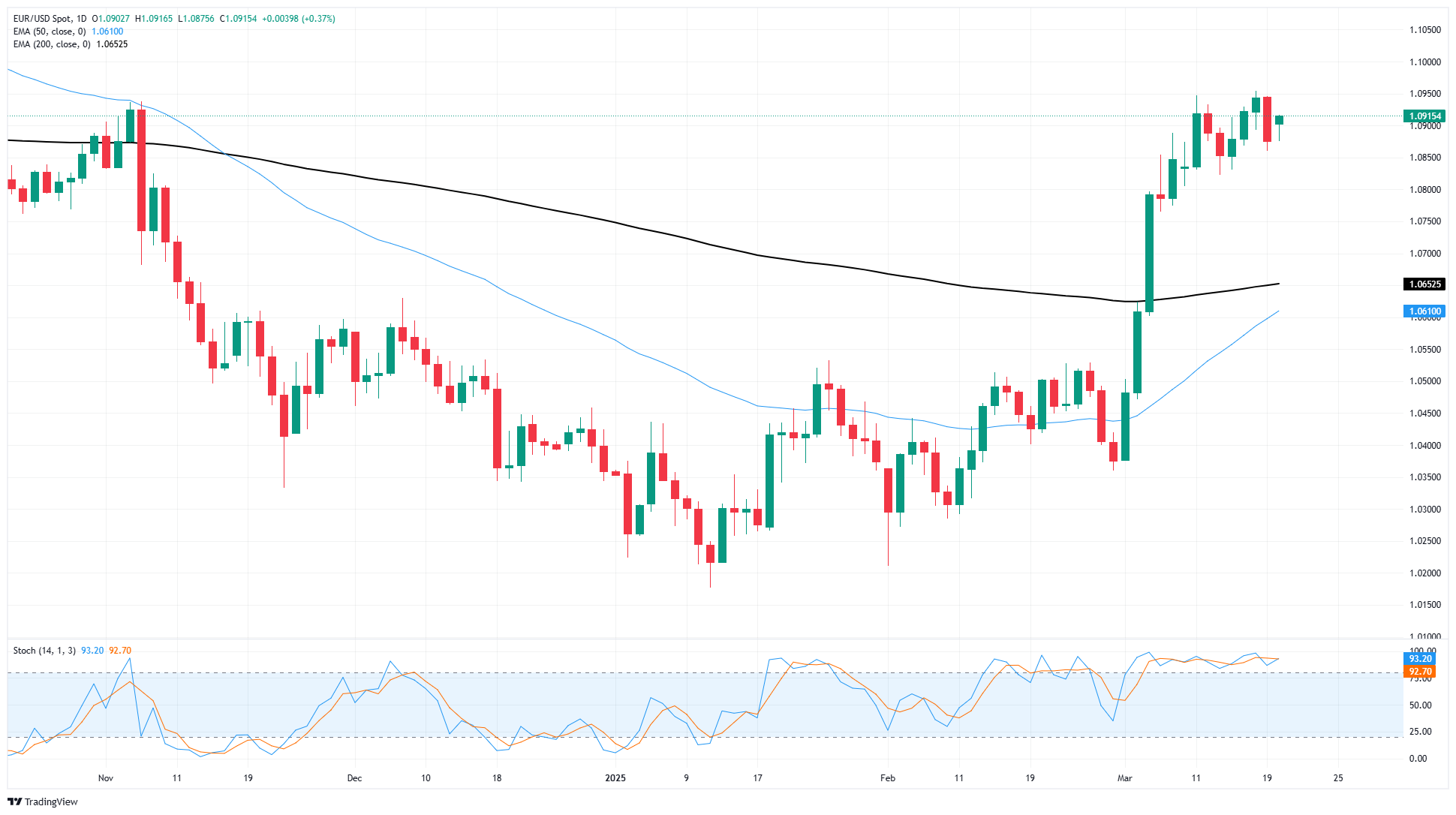EUR/USD holds steady after Fed treads water on rates
- EUR/USD remains hobbled on the south side of 1.1000.
- The Fed held interest rate steady, as investors expected.
- Despite downside risks to growth and inflation, Fed still sees rate cuts in 2025.
EUR/USD remained bolstered above the 1.0900 handle on Wednesday, propped up by a general easing in Greenback flows after the Federal Reserve (Fed) met markets in the middle and held rates steady for another meeting. Fed Chair Jerome Powell noted that growth projections for 2025 have been significantly hindered by the Trump administration's erratic policy of announcing trade tariffs on social media only to later retract them. As a result, the Federal Open Market Committee (FOMC) revised its end-2025 Gross Domestic Product (GDP) forecast to 1.7%, a sharp decline from the 2.1% estimate shared in December.
Fed's Powell: We are not going to be in any hurry to move on rate cuts
Additionally, the median dot plot suggests that the end-2025 interest rate will remain at 3.9%, indicating little change since the last policy meeting. The FOMC plans to begin slowing down its balance sheet runoff starting in April. Rate markets continue to signal a greater than 50% chance of a quarter-point rate cut in June, with most rate traders assigning a 65% probability of a quarter-point or larger cut on June 18.
Despite rising risks to the US economy from lagging growth metrics and increasing concerns that the US's erratic tariff policy could trigger both new inflation and an economic recession simultaneously, Fed Chair Jerome Powell stated on Wednesday that the current economic outlook remains generally healthy, and the Fed is not in a hurry to alter its expectations of at least two more rate cuts later in the year.
European Central Bank (ECB) President Christine Lagarde will be making an appearance on Thursday, and the latest round of the EU’s Leadership Summit also kicks off. ECB talking points are highly unlikely to produce nearly as many sparks as the Fed’s outing on Wednesday, so Fiber impacts are set to remain muted.
EUR/USD price forecast
From a technical viewpoint, the Stochastic Oscillator is currently in overbought territory above 80.00, though it is showing signs of flattening, indicating a reduction in bullish momentum. Meanwhile, the Moving Average Convergence Divergence (MACD) displays flat green bars, suggesting a lack of strong trend conviction. Collectively, these indicators imply that the pair may enter a consolidation phase prior to making a definitive move.
Looking ahead, resistance is positioned at the 1.1000 level, which has historically served as a significant barrier. On the downside, initial support can be found around 1.0850, with more substantial support near the 20-day moving average close to 1.0800. A decline below these thresholds could trigger a corrective reaction, while consistent trading above 1.0900 would maintain the overall bullish outlook.
EUR/USD daily chart
Euro FAQs
The Euro is the currency for the 19 European Union countries that belong to the Eurozone. It is the second most heavily traded currency in the world behind the US Dollar. In 2022, it accounted for 31% of all foreign exchange transactions, with an average daily turnover of over $2.2 trillion a day. EUR/USD is the most heavily traded currency pair in the world, accounting for an estimated 30% off all transactions, followed by EUR/JPY (4%), EUR/GBP (3%) and EUR/AUD (2%).
The European Central Bank (ECB) in Frankfurt, Germany, is the reserve bank for the Eurozone. The ECB sets interest rates and manages monetary policy. The ECB’s primary mandate is to maintain price stability, which means either controlling inflation or stimulating growth. Its primary tool is the raising or lowering of interest rates. Relatively high interest rates – or the expectation of higher rates – will usually benefit the Euro and vice versa. The ECB Governing Council makes monetary policy decisions at meetings held eight times a year. Decisions are made by heads of the Eurozone national banks and six permanent members, including the President of the ECB, Christine Lagarde.
Eurozone inflation data, measured by the Harmonized Index of Consumer Prices (HICP), is an important econometric for the Euro. If inflation rises more than expected, especially if above the ECB’s 2% target, it obliges the ECB to raise interest rates to bring it back under control. Relatively high interest rates compared to its counterparts will usually benefit the Euro, as it makes the region more attractive as a place for global investors to park their money.
Data releases gauge the health of the economy and can impact on the Euro. Indicators such as GDP, Manufacturing and Services PMIs, employment, and consumer sentiment surveys can all influence the direction of the single currency. A strong economy is good for the Euro. Not only does it attract more foreign investment but it may encourage the ECB to put up interest rates, which will directly strengthen the Euro. Otherwise, if economic data is weak, the Euro is likely to fall. Economic data for the four largest economies in the euro area (Germany, France, Italy and Spain) are especially significant, as they account for 75% of the Eurozone’s economy.
Another significant data release for the Euro is the Trade Balance. This indicator measures the difference between what a country earns from its exports and what it spends on imports over a given period. If a country produces highly sought after exports then its currency will gain in value purely from the extra demand created from foreign buyers seeking to purchase these goods. Therefore, a positive net Trade Balance strengthens a currency and vice versa for a negative balance.


